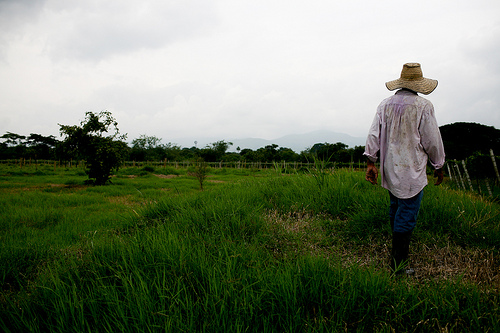Assessing Business Firms' Climate Change Adaptation Responses and Contributions to Adaptive Capacity
I started my career as a corporate lawyer, but shifted my work focus to development cooperation and geography by working on research projects on relief and reconstruction in urban and coastal contexts. These experiences have led to my current work at the intersection of business, climate change and spatial views of adaptive capacity. The recognition of interdependence of firms, workers and their families, and community all come closer into focus, particularly in developing countries.
Within this context, we can recognize that in the broad organizational landscape, business firms are amongst those actors that will need to play a key role in building adaptive capacity. The IPCC report (2012: p. 345) recognizes that different types of actors play different but complementary roles according to their accepted functions and capacities. However, the private sectors functions and capacities in the context of climate change adaptation have only begun to be understood.
In order to approach this issue, I developed - through my PhD research- a framework that integrates different aspects of business models with different dimensions of adaptive capacity, which can analyse how certain actions might lead to contributions to adaptive capacity amongst different scales in communities where business firms operate.

Photo Credit: Charlotte Kesl /World Bank: Member of a passionfruit producers' alliance near Buga, Colombia.
It is central to the evaluation of adaptation projects, which have business firms as partners or stakeholders, to consider how these firms recognize interdependence as a resource for adaptation. The challenges emerging from the impacts of climate change require re-conceptualizing business functions and identifying drivers that can open opportunities for firms to contribute to adaptive capacity. For example: An agricultural firm in Nicaragua that was faced with undertaking 'necessary strategies for adaptation to climate change and was successful in reducing the production risks, like: droughts, floods, storms and damaged roads by heavy rainfall. Extreme weather events impacted the production chain before and natural events almost led to the bankruptcy of the company and its associate producers' (see UNFCCC Private Sector Initiative Case Study of Chiles de Nicaragua, SA.).
The firm undertook different actions, such as sharing of knowledge, which according to the company led to favorable credit, technical, productive and associative conditions for other producers, particularly those in their supply chain. They also provided technical assistance and "increased regular visits of their technical team to their suppliers to help them in: a proper selection of the location for the crop, correctly transplant healthy and costly seedlings, supervising that the plots and ridges are well constructed to avoid flooding in the crop plantation area, that the irrigation system and plastic mulch are correctly installed" (idem). This will contribute to supplier's adaptive capacity by allowing them to have stable production with the use of water efficient irrigation systems and plastic mulch to that allows them to produce year round independent of climate variations and reduce water use.
Another dimension where the firm has supported adaptive capacity is by engaging in policy discussions with the regional governments to improve climate change policy for their sector and improve glitches in the regional private sector strategy for climate adaptation in Central America. The firm also promoted "good agricultural and manufacturing practices, and corporate social responsibility in all the production chain, emphasizing awareness and training of the actors on climate change" (idem).
Assessing the real contributions of the firm towards adaptive capacity requires a closer study of the projects, actors and outcomes. However, the actions can be examined independently to understand how these contribute to creating adaptive capacity in a given system. The assessment begins by using an evaluation framework that places the firm in its operational site at the centre of an interconnected system of actors, which might include local government, competitor firms, employees, and households, amongst many other local actors.
This perspective provides an entry point to think about the different ways in which firms can co-produce adaptive vision and capacity in coordination with other actors. It can also shed light on the contributions and tensions arising from an individual firm's actions along resource supply-chains, amongst workers and host communities in their same operational spaces.
I presented part of the framework in the GEF conference this past November, and currently I am beginning to pilot the framework with agricultural firms and fisheries in Latin America for developing a private sector evaluation and strategy tool. Ultimately, assessing contributions and responses is about finding new pathways for businesses that reframe the functions of the business firm in the context of climate change.
Suggested readings:
- Agrawala, S. et al., (2011a) "Private Sector Engagement in Adaptation to Climate Change: approaches to managing climate risks", OECD Environment working group papers, No. 39, OECD publishing.
- Berkhout, F., Hertin, J. and Arnell, N. (2004) "Business and Climate Change: Measuring and Enhancing Adaptive Capacity" Tyndall Centre for Climate Change Research, Technical report 11.
- Biagini, B. & Miller, A., (2013) "Engaging the private sector in adaptation to climate change in developing countries: importance, status, and challenges". Climate and Development, 5(3), pp.242–252.
- IPCC (2012) Managing the Risks of Extreme Events and Disasters to Advance Climate Change Adaptation. A Special Report of Working Groups I and II of the Intergovernmental Panel on Climate Change.
- McLaughlin, P. (2011) Climate Change, Adaptation, and Vulnerability: Re-conceptualizing Societal-Environment Interaction within a Socially Constructed Adaptive Landscape. Organization & Environment, 24(3), pp.269–291.
- Nitkin, D. (2013). "Business Adaptation to climate change: a systematic review of the literature". Network for Business sustainability.
- Pauw, P. and Pegels, A., (2013). Private sector engagement in climate change adaptation in least developed countries: an exploration. Climate and Development, 5(4), pp.257–267.
- Pelling, M. and Schipper, L. (2006). Disaster Risk, climate change and international development: a scope for, and challenges to, integration. Disasters, 2006, 30 (1) 99. 19-38, Overseas Development Institute.
- Pelling, M, O'Biern, K. and Matyas, D. (2015) "Adaptation and transformation" Climatic Change, Vol. 128, No. 1-2, 2015, Springer
About the author
Jose Di Bella is a PhD researcher at Kings College London. He is part of the Environment, Politics and Development Group in the Department of Geography. Currently working on business firm's contributions to adaptive capacity, emerging business models and scenarios for equitable transformation in developing countries. He practiced corporate law (LL.B) and has worked for seven years as a researcher in international cooperation on issues of sustainable development, climate mitigation and disaster reconstruction.



